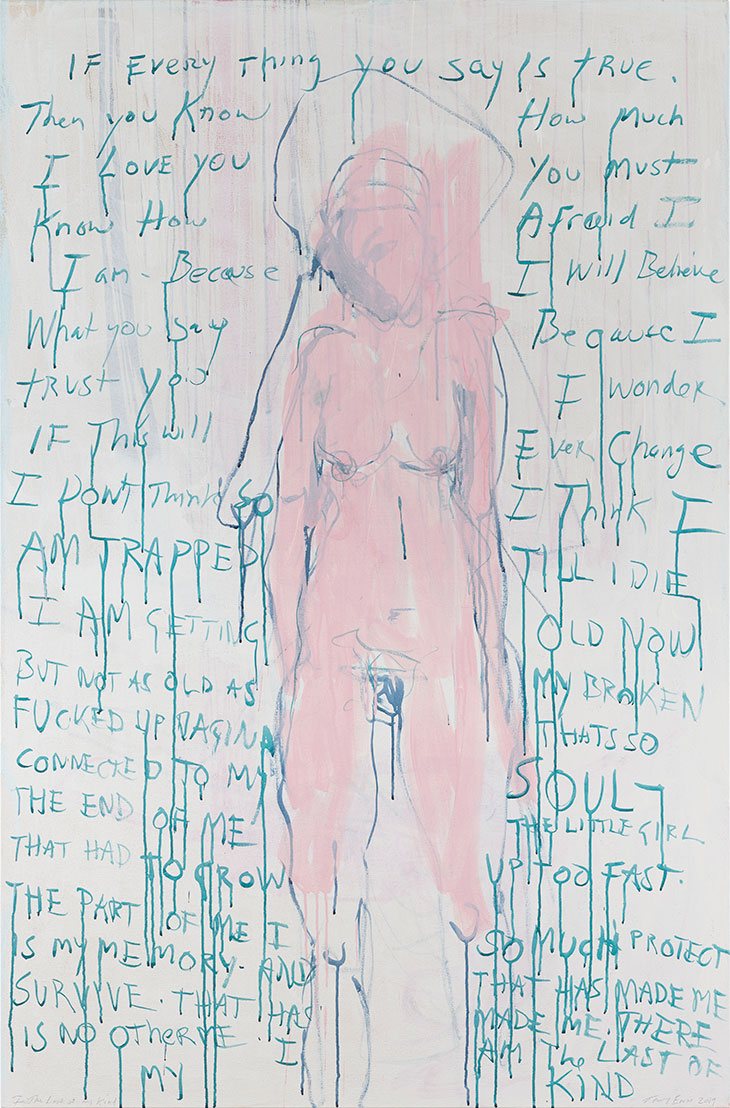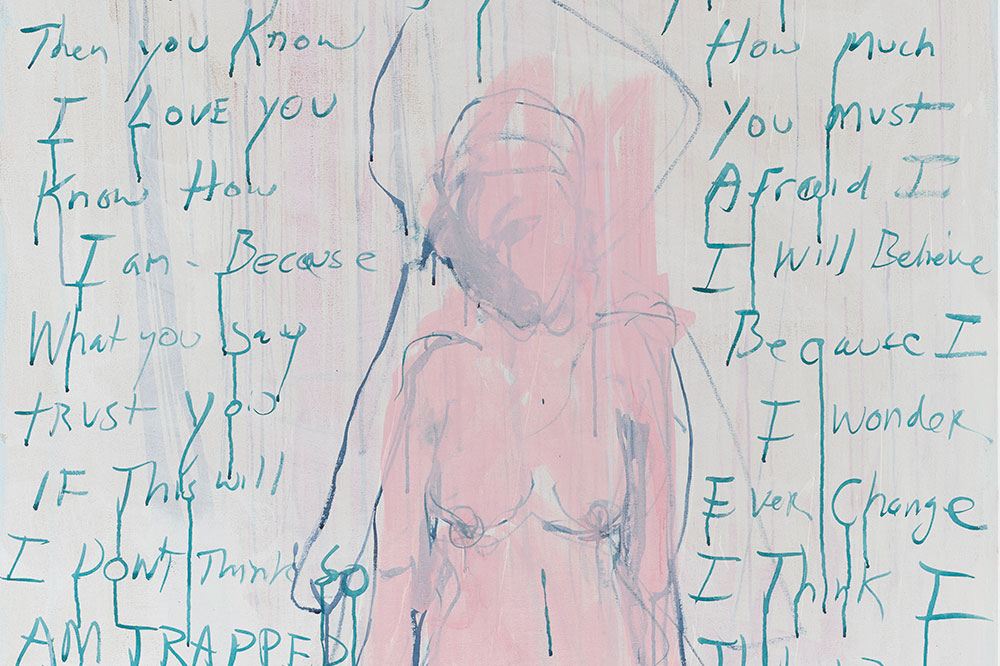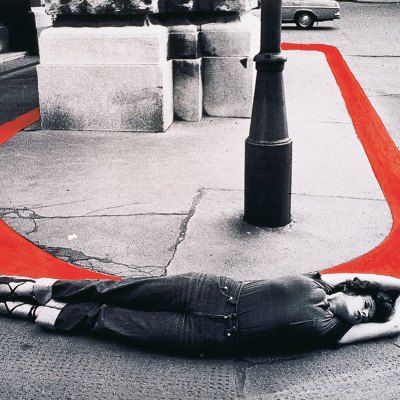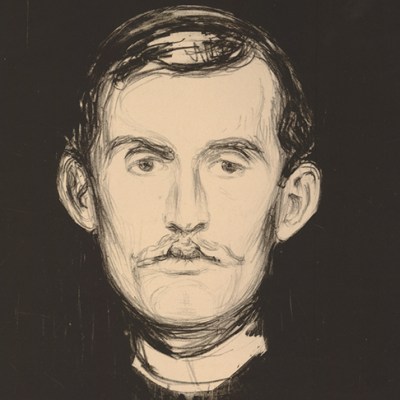Tracey Emin has been saying goodbye since the moment she arrived. When she got her first gallery show back in 1993, at the newly opened White Cube, she christened it ‘My Major Retrospective’, convinced that between self-destructive partying and bouts of depression, it would probably be her last, too. Though the intervening decades have only proven her staying power, her art has continued to communicate a valedictory sentiment: from the sexual memorial of Everyone I Have Ever Slept With 1963–1995 (1995) to the slew of titles that, like The Last Thing I Said to You is Don’t Leave Me Here (1999), have read as telegraphic snippets from a never-ending breakup. Like the slamming of a door, her work conveys the desire to be off and away, and to be remembered indelibly in the process – while forever sneaking back, to see how the grand exit has gone down.
This urge is as strong as ever in ‘The Loneliness of the Soul’, where Emin’s work hangs side by side with a selection of paintings by Edvard Munch. Though there is real dialogue here, Emin’s side of the show is interested above all in continuing her farewells: her wiry paintings and small, stark sculptures place her perspective on the parting of lovers alongside the same themes of abjection and pain that have marked her whole life and work. Mostly female figures line up – or, for the most part, lay down – to proclaim that This is life without you – You made me Feel like This (2018), There is nothing left but you (2013), I never Asked to Fall in Love – You made me Feel like This (2018). There is, as there always has been, humour too, dug out of the melodrama of confession. In one of the sculptures here, Humiliated (2013), a lone white swan floats across a whited block of bronze, bashfully small above the graven block capitals of the title.
Because you left (2016), Tracey Emin. Private collection. © Tracey Emin. All rights reserved, DACS 2020

It works because it never feels like an act: Emin’s work is flooded with feeling. Like the female figure in Open Heart (2018), kneeling before an inscrutable idol, half-obscured behind a block of dripping rust-red, she gives the sense that she has stripped and offered herself up to the viewer. When she wants to say how she feels, she really does. Her sentiments are never anything less than direct, too. One of the older pieces here, a trademark neon sign, reads, in all-caps, MY CUNT IS WET WITH FEAR (1998), and the painted nudes that make up the bulk of the show seem to illustrate exactly that state: legs spread, bent over, arching or writhing, genitals picked out in stark acrylic blurs, pained or ecstatic or both at once. Her latter years’ journey to the centre of the art establishment – RA in 2007, RA Professor of Drawing in 2011, and CBE in 2013 – has done nothing to soften her, but it has allowed her to put her painterly traditionalism on full display. Her figures stretch out in thin, fast lines, attenuating into long tangles of running pigment, faces blank or obliterated behind slashed daubs and blocks of black or red; their poses hum against softly hued grounds reminiscent of Guston or Twombly.
Female Nude (1919–1924), Edvard Munch. Munchmuseet, Oslo

While Emin’s work stands happily – or unhappily – on its own, seeing it alongside Munch’s is doubly illuminating. There is always risk in juxtaposing working artists with canonical figures, especially when a debt is as strongly acknowledged as it is here – Emin talks of Munch as having been her favourite artist since she was 17 or 18, and she has made work responding directly to his since her art school days. The selection of Munch’s work here is Emin’s own, picked from the several thousand pieces in the archive of the Munchmuseet in Oslo, and it is a fine one. While in the show’s catalogue Emin describes her choice as focused on ‘loneliness and vulnerability and the fragileness of emotions’ – Munch’s forte by any reckoning – it seems even more simply to have been driven by her fandom, by wanting others to love Munch as much as she does. For all their kinship with Emin’s own vulnerable figures, most of the pieces here are simply, above all, beautiful. In a set of painted sketches grouped together in the first room, his female nudes flow in swift watercolour contours, calligraphically laid down in blues, reds, and yellows: alone, not isolated, they dress and undress, step from baths or curl on beds, voluptuous. They are Munch at his tenderest – his most likeable.
The Death of Marat (1907), Edvard Munch. Munchmuseet, Oslo

There are tougher pieces, too, though, where Emin’s own sense of pain and isolation resonates loudly with her hero’s. Model by the Wicker Chair (1919–1921) features the same faceless pain, the model alone in the deep space of an apartment, stripped, and looking down at a vivid red stain on the seat of the chair beside her. In The Death of Marat (1907), the assassin Charlotte Corday stands, facing the viewer front on, her victim behind her – not in his bath as in David’s version of the event, but stretched across his bed. Both of them are naked, as if passion, not politics, were the cause of the crime. Just as in Emin’s world, break-ups seem to be a species of slow murder, and vice versa.
I am The Last of my Kind (2019), Tracey Emin. Courtesy Galleria Lorcan O’Neill © Tracey Emin. All rights reserved, DACS 2020

The pairing works well, though, less because of the debt it acknowledges than the differences it points up. Munch’s bodies are all contour: every line a solid curve of flesh – too, too solid, seems to be the message. Emin’s are stubborn fragile outlines: lengths of wire that seem simultaneously tough and ductile, and delicately prone to cutting, snapping, breaking off. The stubborn fragility is Emin’s trademark, and the reason she has been saying goodbye all this time. If you believe, as Emin seems to, that there is not much more than will and emotion holding it all together, you need to be stubborn: extinction is only ever a lapse of concentration away. And as she puts it in the newest piece here, I am The Last of my Kind (2019). With news of her recent treatment for cancer and the ruin it has wrought on her body hanging over the show, I was left hoping that this was not goodbye after all.
‘Tracey Emin/Edvard Munch: The Loneliness of the Soul’ is at the Royal Academy, London, until 1 August 2021.



